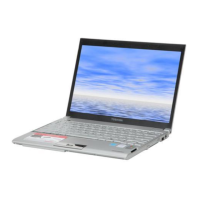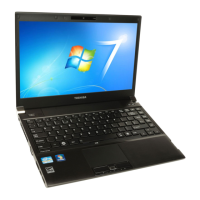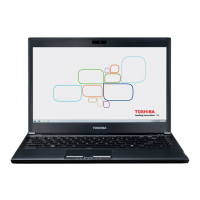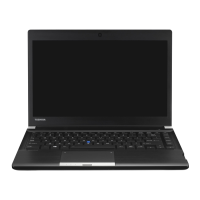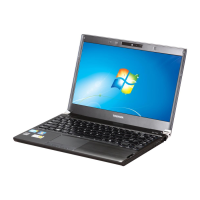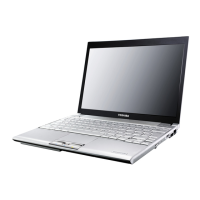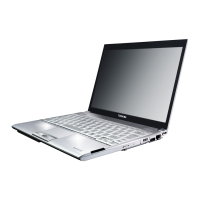
Do you have a question about the Toshiba Portege R500 and is the answer not in the manual?
Lists hardware and documentation included with the computer.
Basic steps for starting computer use and initial setup.
Step-by-step guide on connecting the AC adaptor for power.
Steps to power on the computer and check indicators.
Guidance for the first-time setup of the operating system.
Explains how to shut down the computer in different modes.
How to place the computer into Sleep Mode to interrupt work.
Saving memory to disk for later restoration.
Feature for repairing startup issues or restoring the system.
Instructions for creating recovery discs for software backup.
Steps to restore pre-installed software from the recovery partition.
Instructions to restore software using created recovery discs.
Details ports and features on the left side of the computer.
Details ports and features on the right side of the computer.
Details about the computer's Intel® processor.
Details on graphics, sound, LAN, Bluetooth, and Wi-Fi.
Utilities for accessibility support and fingerprint authentication.
Step-by-step instructions for inserting and removing PC Cards.
Instructions for inserting and removing SD/SDHC cards.
Guidance on installing and removing optional memory modules.
Step-by-step instructions for installing a memory module.
Step-by-step instructions for removing a memory module.
Steps to connect an external monitor to the computer.
Instructions for connecting the USB floppy diskette drive.
Steps to connect the i.LINK cable to the computer and device.
Instructions for attaching a security cable to the computer.
Instructions on operating the Touch Pad and its control buttons.
Overview of the fingerprint sensor and its capabilities.
Steps for correct finger swiping for registration and authentication.
Steps for setting up fingerprint authentication and registering fingerprints.
Procedures for removing stored fingerprint information.
Using fingerprint authentication for Windows logon process.
Steps for authenticating using the fingerprint sensor.
Using fingerprint authentication before the operating system loads.
Steps to enable and configure Pre-OS fingerprint authentication.
Using one fingerprint for both BIOS and Windows logon.
How to use the computer's optical disc drives for program execution.
Step-by-step instructions for loading discs into the tray.
Steps for removing discs from the disc tray.
Guide to writing data to CDs/DVDs using the drive.
Key points to observe during CD/DVD writing or rewriting operations.
Details on Wireless LAN compatibility and standards.
Steps to connect to a wireless network and security recommendations.
Information on the Bluetooth software and its supported OS.
How to connect and disconnect to a Local Area Network.
Step-by-step instructions for connecting the LAN cable.
Guidelines for cleaning the computer's exterior and display.
Safety precautions to take when moving the computer.
How HDD Protection reduces damage risk from shocks and vibrations.
How to adjust HDD Protection settings and detection levels.
System management of internal temperature to prevent overheating.
Describes function keys and FN key combinations for soft keys.
Lists hot key combinations for quick access to system features.
How power status is affected by AC connection and battery charge.
How to interpret Battery, DC IN, and Power indicators.
Explains the meanings of Battery indicator lights (orange, blue, no light).
Describes the removable battery pack and the RTC battery.
Important safety precautions for handling the battery pack.
How to recharge the battery pack and indicators during charging.
Conditions affecting charging and how to monitor battery capacity.
Factors influencing battery life and tips for extending it.
Procedures to maximize the lifespan of battery packs.
Step-by-step instructions for removing the battery pack.
Step-by-step instructions for installing the battery pack.
How to set, delete, or change user passwords.
Setting up and managing supervisor passwords and tokens.
Ways to start the computer when a password is registered.
Explains Boot Mode, Hibernation Mode, and Sleep Mode.
Steps to enter, exit, and save BIOS setup configurations.
Guidelines for identifying and resolving computer problems effectively.
Steps to install the manager on Windows XP or Vista.
